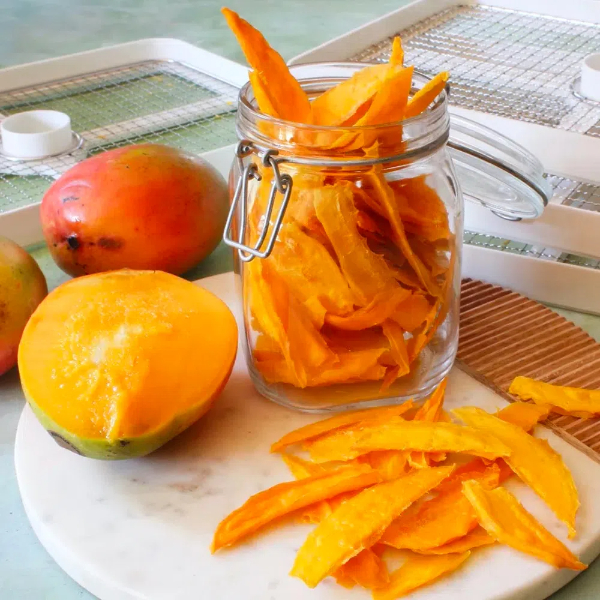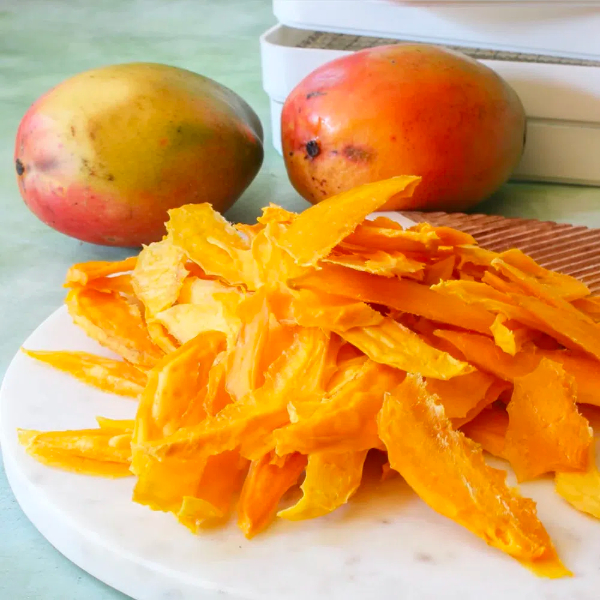
Content Menu
● Why Use a Food Dehydrator?
● Ingredients Needed
● Equipment Required
● Step-by-Step Guide to Drying Mango
>> Step 1: Selecting the Right Mangoes
>> Step 2: Preparing the Mangoes
>> Step 3: Arranging the Slices
>> Step 4: Setting Up the Dehydrator
>> Step 5: Drying Process
● Tips for Perfectly Dried Mango
● Creative Uses for Dried Mango
● Nutritional Benefits of Dried Mango
● Conclusion
● FAQ
>> 1. How do I know when my mango is fully dried?
>> 2. Can I use frozen mango for drying?
>> 3. What can I do with leftover dried mango?
>> 4. How should I store my dried mango?
>> 5. Can I dry other fruits in my dehydrator?
● Citations:
Drying mango in a food dehydrator is a simple and rewarding process that allows you to enjoy this tropical fruit year-round. Dried mango makes for a delicious snack, packed with nutrients and flavor. This guide will take you through the steps to effectively dry mango using a food dehydrator, along with tips, tricks, and frequently asked questions.

Why Use a Food Dehydrator?
Using a food dehydrator has several advantages over other drying methods:
- Controlled Environment: Dehydrators provide a controlled temperature and airflow, ensuring even drying without cooking the fruit.
- Preservation of Nutrients: The low temperatures used in dehydrators help retain the vitamins and minerals found in fresh mango.
- Convenience: You can set it and forget it, allowing you to focus on other tasks while your mango dries.
Ingredients Needed
- Ripe mangoes (the number depends on your dehydrator capacity)
- Optional: lemon juice or sugar for flavoring
Equipment Required
- Food dehydrator
- Sharp knife
- Cutting board
- Airtight storage containers
Step-by-Step Guide to Drying Mango
Step 1: Selecting the Right Mangoes
Choose ripe mangoes that are slightly soft to the touch. The best varieties for drying include Haden, Tommy Atkins, or Kent. Avoid overripe or underripe mangoes as they may not dehydrate well.
Step 2: Preparing the Mangoes
1. Wash the Mangoes: Rinse under cold water to remove any pesticides or dirt.
2. Peel the Mangoes: Use a sharp knife or vegetable peeler to remove the skin.
3. Slice the Mangoes: Cut the flesh into uniform slices about ¼ inch thick. Consistent thickness ensures even drying.
Step 3: Arranging the Slices
Place the mango slices in a single layer on the dehydrator trays. Ensure there is enough space between each piece for air circulation. If desired, you can sprinkle lemon juice or sugar on top for added flavor.
Step 4: Setting Up the Dehydrator
Set your food dehydrator to 135°F (57°C). This temperature is ideal for drying fruits without cooking them.

Step 5: Drying Process
1. Dehydrate: Allow the mango slices to dry for approximately 8 to 12 hours. The exact time will depend on your dehydrator model and the thickness of your slices.
2. Check for Doneness: Start checking around 6 hours. The dried mango should be pliable and not sticky or wet. If it feels moist, continue drying until it reaches the desired texture.
Dehydrating Process
Step 6: Cooling and Storing
Once dried, remove the mango slices from the dehydrator and let them cool completely at room temperature.
Store them in airtight containers or vacuum-sealed bags in a cool, dark place. Properly stored dried mango can last up to a year.
Tips for Perfectly Dried Mango
- Uniform Slices: Ensure that all slices are of similar thickness for consistent drying.
- Flip Slices: Halfway through drying, flip the slices over to promote even dehydration.
- Avoid Over-Drying: Dried mango should be chewy but not brittle. Over-drying can lead to loss of flavor and nutrients.
Creative Uses for Dried Mango
Dried mango can be enjoyed in various ways beyond snacking:
- Trail Mix: Combine dried mango with nuts, seeds, and other dried fruits for a nutritious trail mix.
- Smoothies: Rehydrate dried mango in warm water before blending it into smoothies for added sweetness and flavor.
- Baking: Incorporate chopped dried mango into muffins, bread, or granola bars for a tropical twist.
- Salads: Add dried mango pieces to salads for a burst of sweetness that complements savory ingredients.
Nutritional Benefits of Dried Mango
Dried mango is not only delicious but also packed with nutrients:
- Rich in Vitamins: Dried mango is an excellent source of vitamins A and C, which are essential for immune function and skin health.
- High in Antioxidants: The antioxidants found in mango help combat oxidative stress and may reduce inflammation.
- Dietary Fiber: Dried mango provides dietary fiber, which aids digestion and helps maintain a healthy gut.
Conclusion
Drying mango in a food dehydrator is an excellent way to preserve this delicious fruit while maintaining its nutritional value. With just a few simple steps, you can create healthy snacks that are perfect for on-the-go munching or adding to recipes. Enjoy your homemade dried mango as is or incorporate it into smoothies, granola bars, or trail mixes!

FAQ
1. How do I know when my mango is fully dried?
Your dried mango should be pliable and not sticky or wet. If you bend it and it cracks, it's over-dried; if it feels moist, continue drying until it's just right.
2. Can I use frozen mango for drying?
Yes, you can use frozen mango, but make sure to thaw it completely before slicing and placing it in the dehydrator.
3. What can I do with leftover dried mango?
Leftover dried mango can be added to smoothies, salads, or oatmeal; used as a topping for yogurt; or enjoyed as a snack on its own.
4. How should I store my dried mango?
Store dried mango in an airtight container in a cool, dark place. For longer shelf life, consider vacuum sealing it.
5. Can I dry other fruits in my dehydrator?
Absolutely! Many fruits such as apples, bananas, and strawberries can also be dried using similar methods in your food dehydrator.
Citations:
[1] https://www.mangoprocess.com/how-to-dry-mangoes-in-a-dehydrator-a-step-by-step-guide/
[2] https://emilyfabulous.com/how-to-make-dried-mango/
[3] https://thevintagecook.com/dehydrated-mango/
[4] https://flouronmyface.com/how-to-dehydrate-mango/
[5] https://www.youtube.com/watch?v=jYcXqMqW8VQ
[6] https://www.freshoffthegrid.com/dried-mango/
[7] https://www.backpackingchef.com/dehydrating-mango.html
[8] https://www.myforkinglife.com/dehydrated-mango/
[9] https://www.excaliburdehydrator-recipes.com/recipe/dehydrated-mangoes/
[10] https://selfsufficientme.com/preserving-mango-through-dehydration-drying/











